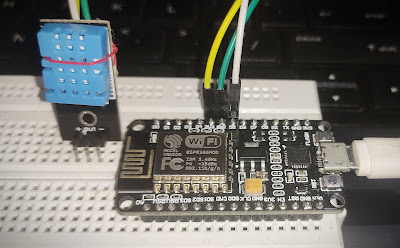MicroPython #4: Interfacing Sensors

MicroPython Interfacing Sensors DHT-11 Sensor interphase with NodeMCU At the end of this, you will be able to interphase DHT11 Temperature Sensor with ESP 8266 NodeMCU bare-metal and also by attaching external LED's. The whole process will be done by MicroPython programming. So, Let's begin with ! Note: You must have your MicroPython firmware pre-flashed onto your board before beginning with this. If not, follow up these before getting back here. MicroPython #1: Introduction and Gearing U p MicroPython #3: PWM, LED Fade MicroPython #2: Triggering I/O's Introduction to DHT 11 and Sensor Interphase The DHT11 is a basic, ultra low-cost digital temperature and humidity sensor. It uses a capacitive humidity sensor and a thermistor to measure the surrounding air, and spits out a digital signal on the data pin. Here, we'll operate it on Analog mode. There is a dht module that comes with the MicroPython firmware by default. So,...


